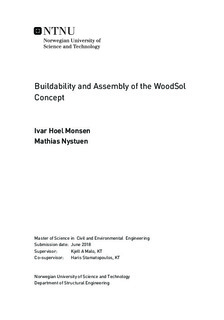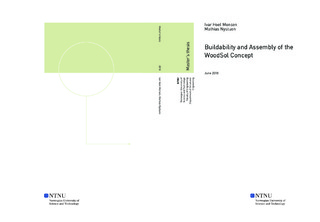| dc.description.abstract | This master thesis is part of the research program WoodSol, and aims to check the buildability and assembly aspects of WoodSol, as well as the economic, transportational and environmental aspect. In this process, assumptions are made based on the previous work of the WoodSol project.
The buildability for an introduced reference building is investigated. The main areas considered in the buildability aspect are the size and rotational stiffness of the foundations and the variation of the different components impact on the final rotational stiffness. The obtainable rotational stiffness of the foundation is in the range of 3315-11460 [kNm/Rad]. This is found numerically, and checked for the serviceability limit state for the reference building. The size of the foundations are found considering the forces acting on the columns. These forces are found both numerically and analytically. The necessary foundation size varies with regards to the soil stiffness, but for loose gravel and eight stories the proposed solution is a strip foundation with a width of 3300 millimeters and height of 500 millimeters. The volume of the concrete foundation for the reference building is found to be 30-42% lower than the foundation for an equivalent concrete building, when built on fine sand or loose gravel.
Considering the transportational aspect of the project, the deck elements used will be transported by semi-trucks, transporting six elements simultaneously. The columns will be transported by an extendable semi-truck, transporting 14 columns each delivery. This transport will need a police escort and is costly. Other elements and materials have a standardized transportation.
For the assembly aspect, the cost of different cranes is compared depending on the time rented. For the WoodSol project it is concluded that a mobile crane would be the most economic because of the rapid erection time. The lifting process for the different elements is discussed and it is figured out that the columns will be lifted by the pre-installed connectors meant for the deck elements. While the decks will need to have installed eyebolts to make it possible to lift with an angle for easy mounting. Since the columns do not have capacity to stand by them self after mounting, the top deck need to connect four columns as soon as possible after the sufficient number of columns have been erected. The erecting time of the bearing structure is only five days, after the foundations are finished.
The saving of kg CO2-eq polluted, for the reference building built in timber compared to concrete, are 286.082 kg, 433.087 kg, 576.008 kg, for four, six and eight stories respectively. 576.008 kg is equivalent with driving one million new Volvo cars 4,5 kilometers. Costs of the foundations are 30-40% less depending on the stiffness of the ground when building in timber compared to concrete. This is based on the 44% reduction of concrete needed. | |

